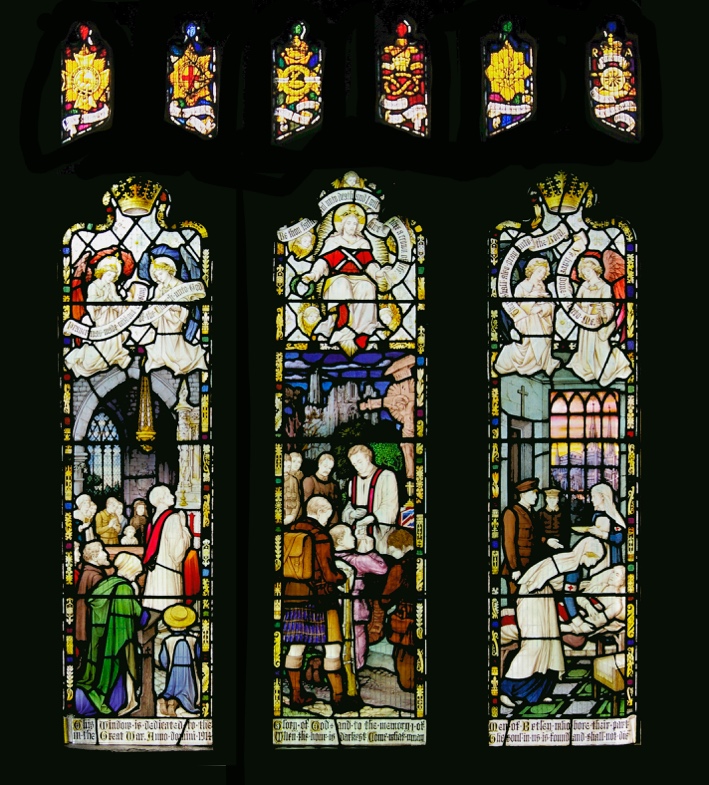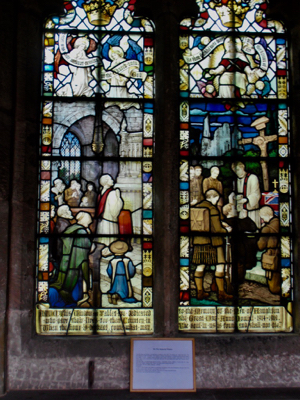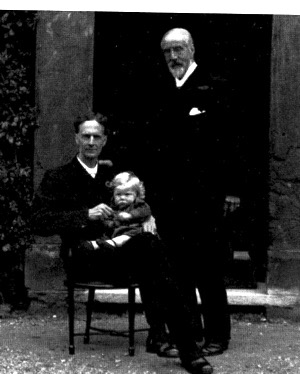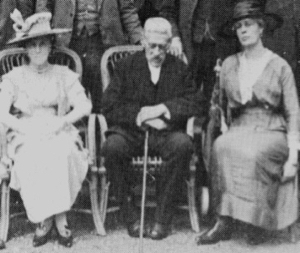A Tale of Two Windows
This project was commissioned to find further information about the Betley Window, who paid for it, who designed it and who authorised it. There are no records at Betley.
During the investigation it was discovered that there are two almost identical WW1 memorial windows in two Staffordshire Churches, Betley and Haughton.
| Betley Window | Haughton Window |
 |
 |
| Note that the Scrolls at Haughton are in a slightly different position to Betley. There are no Tracery Lights at Haughton. Both Windows carry the following Inscription. This Window is dedicated to the glory of God and to the memory of the men of Betley (Haughton) who bore their part in the Great War. Anno Domini 1914. When the hour is darkest! The soul in us is found, and shall not die. (Quotation from Lawrence Binyon) |
|
A check in the records of Staffordshire WW1 Church Memorial Windows shows there are no others similar in Staffordshire. As one of the windows depicts the Bishop of Lichfield it can be reasonable to assume that this design will only be found in the Diocese of Lichfield (Staffordshire and Shropshire). As no others exist it can be safe to assume these were not an off the peg design, but specifically designed for these two parishes.
How then did two very similar windows appear in two churches at opposite end of the county?
Two Vicars
The only obvious connection is the two vicars, our research has shown they were brothers in law, and both were generous to their community.
The Rev. Sir Robert Boughey Bart. was vicar of Betley. His ancestral home was at Aqualate Hall some six miles from Haughton. He was known to be very supportive of the community, he provided equipment for the youth in the Reading Room, he gave school children a penny for every wasp they caught, and it is recorded by one (now deceased) resident that there were no church collections during his time. In his last year the only collections recorded were the Easter Collection and the Harvest Offering.
The Rev Boughey’s family was based at Aqualate, the parish church being Forton, where he is buried. There are a number of windows in Forton Church sponsored by the Boughey family, indicating their liking for stained glass windows.
His Brother in Law at Haughton, the Rev Gilbert Twemlow Royds was also much appreciated in the parish. A memorial to him in the church reads, “Gilbert Twemlow Royds faithful pastor restored adorned and loved this church. A further tablet [Haughton Tablet]describes him as preacher, pastor, antiquary, whose chief memorial was this ancient church. It is recorded that the Rector did not take his stipend.
Very little is known about Betley, the records from this time are very poor, but there is more information on Haughton the search must start there.
Haughton – A tale of two war memorials
The Haughton story starts on December 18th 1918, some six weeks after the end of the war.
A meeting was held in the village to decide on a War Memorial to remember the lives of those fallen. The view of the meeting was that a stone cross in the centre of the village would be the most appropriate, and a committee was formed to raise money and manage the project. There was a minority, led by the Rector, favoured a window in the church, but that was not accepted.
In January the Rector threw a spanner in the works by announcing he had approved a window. He backed down, at least in public, as he did not want to upset the collection of donations for the cross.
By September 1918 the vicar announced that £80 was raised in donations, with a further £26. 16s promised.
A quotation for £112, 10s was accepted for the work. This leaves a shortfall of £5. 14s.
The annual sale of work was held in October and £37 of the proceeds was allocated to the War Memorial Project, leaving a surplus of £31. 6s
The Rector then announced that there were sufficient funds to go ahead with the window as well; he had some more (unnamed) donors. The window would have cost about £100, so some £70 needs to be raised. It is likely the Rector had a hand in this.
Work commenced on both projects.
The window was completed first, and was dedicated on the first Sunday in Lent in February 22nd 1920. The Cross followed and was dedicated in May 1920.
The rector preached the sermon at the dedication of the window, and it is worth examining his sermon in detail, it provides more information. The following is the report of the proceedings as printed in the Parish Magazine.
On the first Sunday in Lent the Rector unveiled and dedicated the War Memorial Window. It was presented by the Churchwardens, as representing the Donors. There was a large congregation. The Rector gave a detailed description of the Window. It has been a real pleasure to him to make and carry through the design, he trusts that it will bring satisfaction and comfort to many, and especially to those who have lost those who were very near and dear to them.
The window has been admirably fixed by Mr T Lea. The subjects are:
Right Hand Light. The Last Communion before the battle. The Chaplin (A portrait of the Bishop of Lichfield) administrating the chalice to a soldier. On the left is a wrecked French Cathedral and on the right a wayside Crucifix.
On the upper panel is our lord in glory with a wreath of holly leaves on the right hand side and a script “Be though faithful until death and I will give you a crown of life.”
On the left hand side is an intersession service at home; clergyman, parents, children, a young wife, a young widow, etc.
Upper panel bearing scrolls “Prayer was made without ceasing of the church and to God.”
Eyelet lights, the Rose, thistle, shamrock and leek.
The inscription:
This window and tablet are dedicated to the memory of the men of Haughton who gave their lives for their country in the Great War, Anna Domini 1914-1918.
When the hour is darkest, come what may, the soul in us is found and shall not die.
Window executed by Dix and Co, London
The text above refers to the [Haughton Tablet] in Haughton Church.
The Description given by the Rev. Royds for the Haughton Window is close to the description by the Imperial War Museum for the Betley Window.
These windows are unusual in that they depict scenes that would have been commonplace at this time, soldiers receiving communion, relatives worshipping at home and (at Betley) nurses and doctors working in a field hospital. This must be the influence of Clement Royds who, when looking at the time scale between the end of the war and the dedication of the Betley Window, must have worked on this idea for some time. More common themes in other memorial windows are based on the bible or St George and the Dragon.
DIX and Co.
It is not surprising that Dix and Co were chosen. Most of the Boughey windows in Forton are executed by Dix and Co, as are other windows at Haughton.
Arthur Dix was born in High Wycombe in 1860. By 1881 he was working as a decorative artist based initially in Berners Street London, later moving to Gower Street. It was about this time that his work went on display at the Royal Academy. Dix built the business up and his work and that of his successors is to be found all over the UK, mainly in Churches and public buildings such as Town Halls.
Arthur Dix died in 1917, just before the Betley/Haughton Window was commissioned, the firm continued in operation until 1940.
Their premises were destroyed in the Second World War, and there are no records available.
And in Betley
In the meantime there was very little happening in Betley: there are no records of any public subscription for a memorial; there is no sign of any local resident stepping forward to manage such a project.
The vicar, to judge by his picture at the show committee, and by his spiderlike signature in the Vestry Minutes, was not in good health.
Unlike most local villages there is no outdoor War Memorial, and the window does not have a tablet, it is normal to have one so that it is known who is commemorated.
It is likely that the Vicar wanted a window, but his health was such that he would have been unable to manage such a project, so he turned to his friend and Brother in Law at Haughton.
Conclusion
Nothing can be proven; it is all on the balance of probability.
This is not an off the peg window design, there are only two.
The Rector of Haughton had a hand in the design.
We think that the Vicar of Betley would have wanted a memorial window and turned to his Brother in Law at Haughton for help.
The Rector at Haughton was happy to help design a window, and this was the window he referred to in January 1919 at Haughton as approved. The Rector would have indicated the elements he wanted, in particular the priest as a portrait of the Bishop of Lichfield has his stamp all over it. It is rare to find a portrait in a stained glass window
The Rector of Haughton dedicated the Betley window in February 1919.
The Rev Robert Boughey is likely to have paid for the window, there appears to be little interest in Betley and he could have afforded the £150, or so, it is likely to have cost.
We have not answered the issue of the inclusion of the Coldstream Guards and Bedfordshire Regiment in the Betley Window. We could find no connection with these regiments at Betley, Forton or Haughton.
Having provided a reasonable explanation for the background of the Betley window there is now another unanswered question, why did there appear to be so little interest in a War Memorial at Betley?
The recent finding by BLHS member Shirley Kennerley of two Staffordshire Advertiser articles supports this conclusion. In February 15th the paper reported the dedication of the Betley window by the Rev Royds. It prints his sermon, which followed the same format as the one he used a year later at Haughton. On October 10th 1925 the paper reports on a visit to Betley. In describing the Church the vicar, Rev G Mildred described the memorial window as representing the ideas or Preb. G Royds of Haughton.
Acknowledgements
The authors wish to thank the staff at the County Record office for their assistance, and the Rev Sue Symons, Rector of Haughton, for showing us her church and answering our questions.
Also a thank you to Shirley Kennerley for the Staffordshire Advertiser articles.
Primary Sources
- Haughton Parish Records and Parish Magazines at County Record Office
- “Haughton, A Staffordshire Village”
- A Guide to the Parish Church of St Giles Haughton
Secondary Sources
- Forton Parish Records, County Record Office
- Betley Parish Records, County Record Office
- Transcripts of conversations with Betley Residents, BLHS
- Lest We Forget, Philip Coops, BLHS
© Alderman David Becket. Dr Anne Becket 2018.
Betley Local History Society

